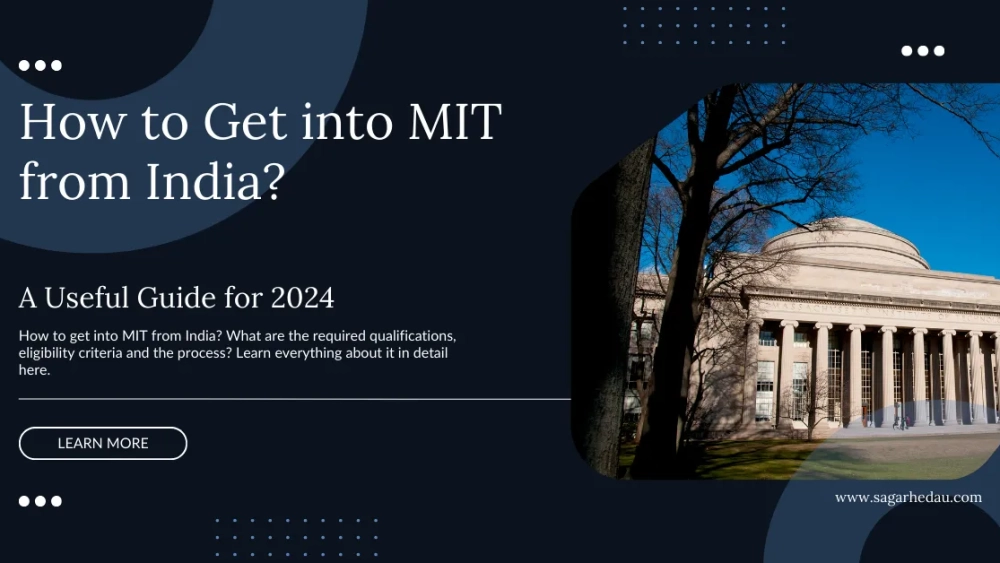Getting into the Massachusetts Institute of Technology (MIT) is a dream for many students around the world, including those from India. Known for its rigorous academics, cutting-edge research, and prestigious reputation, MIT attracts some of the brightest minds. However, the admissions process can be daunting, with a focus on more than just academic excellence.
So, how to get into MIT from India? For Indian students, standing out means showcasing not only top grades and test scores but also leadership, innovation, and a passion for problem-solving. In this guide, we’ll explore the key steps, strategies, and insights needed to increase your chances of getting into MIT from India.
Key Points on How to Get Into MIT from India:
- Understand MIT’s Expectations: Highlighting the importance of academic excellence, extracurricular involvement, and leadership potential.
- Preparation Timelines: Emphasising early preparation starting from high school.
- Application Components: Covering SAT/ACT scores, essays, recommendation letters, and interviews.
- Financial Aid and Scholarships: Exploring available options to support your education.
How to Get Into MIT from India?
We as Indians have a lot of attraction for foreign universities and the pay scale. It is obvious if we also take a look at the current scenario. For this, we try and explore various universities offering top-class programs for the tech and non-tech industries. Massachusetts Institute of Technology (MIT) is one such premier institute in the United States of America. So, how to get onto MIT from India for such courses and education? LEt’s understand in detail.
Understanding MIT’s Admission Criteria
MIT employs a holistic admissions process aimed at identifying students with exceptional potential. The following aspects are crucial:
- Academic Excellence: High scores in standardised tests like the SAT, and a strong academic record. Emphasis on STEM subjects.
- Extracurricular Activities: Active participation in clubs, competitions, and community service. Leadership roles and unique talents are valued.
- Recommendations: Strong letters from teachers and mentors who can highlight the candidate’s abilities and character.
- Essays: Well-crafted personal statements that reflect the applicant’s passions, experiences, and aspirations.
- Interviews: An evaluation of the applicant’s fit for MIT through alumni interviews.
Importance of Academic Excellence
Academic excellence serves as a critical factor in securing admission to MIT from India. MIT evaluates candidates rigorously, focusing on their ability to excel in academic disciplines. Key elements include:
- High GPA: Consistently achieving high grades in advanced subjects.
- Outstanding Test Scores: Excelling in standardised tests like SAT or ACT.
- Strong Foundation in STEM: Displaying proficiency in Science, Technology, Engineering, and Mathematics.
- Research Experience: Engaging in relevant research projects.
- Advanced Coursework: Taking Advanced Placement (AP) or International Baccalaureate (IB) classes.
These academic achievements highlight a candidate’s dedication and readiness for the rigorous MIT curriculum.
Extracurricular Activities and Leadership
Participation in extracurricular activities is crucial for applicants. It showcases a well-rounded personality and the ability to manage time effectively. MIT looks for students who demonstrate leadership, commitment, and impact in their chosen activities.
Key Areas to Focus
- Clubs and Societies: Joining or founding clubs can exhibit leadership skills.
- Community Service: Active involvement in volunteer work highlights a sense of responsibility.
- Competitions and Olympiads: Participating at national or international levels reflects dedication and competitiveness.
- Sports and Arts: Engagement in sports or the arts shows a balanced and diverse profile.
Highlighting significant achievements in these areas can positively influence the application.
Standardised Tests: SAT/ACT and Other Requirements
Standardised tests are pivotal for applicants to MIT from India.
- SAT/ACT:
- SAT: Aimed at assessing a student’s readiness for college. Requires strong math, reading, and writing skills.
- ACT: Evaluates knowledge in English, math, reading, and science with an optional writing test.
- TOEFL/IELTS: Non-native English speakers must prove proficiency in English.
- TOEFL: Internet-based test (iBT) preferred.
- IELTS: An alternative test accepted by MIT.
- Subject Tests: Not required but recommended for showcasing strengths in specific subjects.
Adequate preparation and adherence to deadlines are essential.
Crafting an Impressive Personal Statement
A compelling personal statement is crucial for MIT applications. Key aspects include:
- Authenticity: Reflect true experiences and aspirations.
- Clarity: Maintain clear and precise language.
- Structure: Use a coherent format, typically with an introduction, body, and conclusion.
- Specificity: Highlight particular achievements and experiences.
- Passion: Showcase genuine enthusiasm for the field of study.
- Reflection: Demonstrate thoughtful self-assessment.
- Relevance: Connect personal experiences to MIT’s values and mission.
- Proofreading: Ensure thorough editing for grammatical and spelling errors.
“Great personal statements present a narrative that aligns personal qualities with institutional values.”
Securing Strong Letters of Recommendation
To secure impactful letters of recommendation, applicants must consider the following steps:
- Choose the Right Recommenders: Select teachers or mentors who know the applicant well and can provide detailed insights into their academic and personal qualities.
- Provide Background Information: Offer recommenders a resume, transcript, and list of extracurricular activities and achievements.
- Communicate Clearly: Explain the importance of the recommendation letters and specific aspects the recommender should highlight.
- Request in Advance: Allow ample time for recommenders to write thoughtful and thorough letters.
- Follow-Up: Send polite reminders and express gratitude after receiving the letters.
Building a Balanced College List
Creating a balanced college list is crucial for applicants. It ensures a mix of institutions with varying admission probabilities.
- Research extensively:
- Investigate each college’s academic offerings.
- Check faculty credentials and resources.
- Categorise colleges:
- Reach schools: High-ranked, competitive.
- Match schools: Good fit based on qualifications.
- Safety schools: Likely admission with solid credentials.
- Consider location and environment:
- Urban vs. rural campuses.
- Climate and lifestyle.
- Evaluate financial aid:
- Cost of attendance.
- Scholarship opportunities for international students.
- Review application requirements:
- Standardised test scores.
- Essays, recommendations.
Preparing for the Interview
To prepare for the MIT interview, candidates should focus on the following:
- Research MIT
- Understand its mission, programmes, and culture.
- Learn about notable alumni and faculty.
- Review Application Materials
- Familiarise oneself with essays and recommendations.
- Be prepared to discuss any activities, projects, or achievements mentioned.
- Practice Common Questions
- Anticipate questions about academic interests, career goals, and personal experiences.
- Conduct mock interviews with friends or mentors.
- Showcase Creativity and Problem-Solving
- Be ready to provide examples of creative solutions or innovative projects.
- Demonstrate critical thinking skills.
- Maintain Composure
- Practice mindfulness and stress-relief techniques.
- Dress professionally and ensure a quiet interview environment.
Understanding Financial Aid and Scholarships
For Indian students aiming to study at MIT, a comprehensive understanding of financial aid and scholarships is crucial. The primary types of aid include need-based financial aid, merit-based scholarships, and external scholarships.
- Need-based Financial Aid:
- Awarded based on financial necessity.
- Requires submission of CSS Profile and tax documents.
- Merit-based Scholarships:
- Based on academic and extracurricular achievements.
- May require additional application materials or essays.
- External Scholarships:
- Sponsored by private organisations or government entities.
- Often have separate application processes and criteria.
Financial aid application deadlines are critical. Early application is recommended for maximised aid eligibility.
Timeline and Deadlines: Keeping Track
Understanding the timeline and deadlines is crucial for a successful MIT application process. Careful planning and punctuality are paramount.
- August:
- Begin gathering documents.
- Schedule standardized tests like SAT/TOEFL.
- September – October:
- Request recommendation letters.
- Start MIT application and essay drafts.
- November 1:
- Early Action application deadline.
- January 1:
- Regular Action application deadline.
- February:
- Financial aid documentation submission.
Key deadlines must be met to ensure a complete application. Missing any date may jeopardise the admission chances.
Effective time management and organised tracking are essential. Automate calendar reminders for all critical deadlines.
Common Application Mistakes to Avoid
- Procrastinating: Applicants should not delay their application process. Starting early ensures adequate time for revisions and meeting deadlines.
- Ignoring Instructions: Failing to follow the specific instructions given by MIT can lead to disqualification.
- Weak Essays: Essays should be thoughtfully written, uniquely reflecting the applicant’s experiences and aspirations.
- Generic Recommendations: Choosing recommenders who do not know the applicant well can result in weak, generic letters.
- Incomplete Application: Missing out on parts of the application, such as test scores or extracurricular activities, can weaken an applicant’s profile.
- Overemphasis on Test Scores: Solely focusing on high test scores while neglecting other aspects such as personal essays and extracurricular activities.
Resources and Support for Indian Applicants
MIT offers several resources tailored to Indian applicants to streamline their application process:
- International Students Office: Provides guidance on visa requirements, financial aid, and living in the US.
- MIT-Alumni Clubs in India: Local alumni provide mentorship and share their experiences.
- College Board India Global Alliance: Offers SAT fee reductions and financial aid information.
- EducationUSA India: Offers webinars, in-person advising, and application workshops.
- Online Forums: Platforms like College Confidential and Quora provide peer advice and insights.
- Local Test Centres: Information on SAT, TOEFL, and ACT centres and scheduling in India.
Success Stories: Indian Students at MIT
Indian students at MIT showcase resilience and intellect through various accomplishments. Some key examples include:
- Rohan Narang:
- Graduated with a double major in Computer Science and Electrical Engineering.
- Founded a start-up, now valued at over $100 million.
- Ananya Sharma:
- Completed a PhD in Biotechnology.
- Awarded MIT Technology Review’s Innovators Under 35.
- Vikram Patel:
- Innovated a sustainable water purification system.
- Led a research team that received international recognition.
“The rigorous curriculum and collaborative environment at MIT have truly shaped my academic and professional journey.” – Ananya Sharma
Conclusion and Final Tips
Aspiring students from India should focus on showcasing their unique talents and diverse backgrounds. Efficiently managing time for application components is crucial. Here are a few final tips:
- Start Early: Begin the preparation well before the application deadline.
- Research Thoroughly: Understand MIT’s culture and values.
- Craft a Strong Essay: Communicate personal experiences authentically.
- Seek Recommendations: Get letters from those who can attest to academic and extracurricular strengths.
- Stay Organised: Keep track of deadlines and required documents.
Following these steps increases the chances of success in gaining admission to MIT from India.

